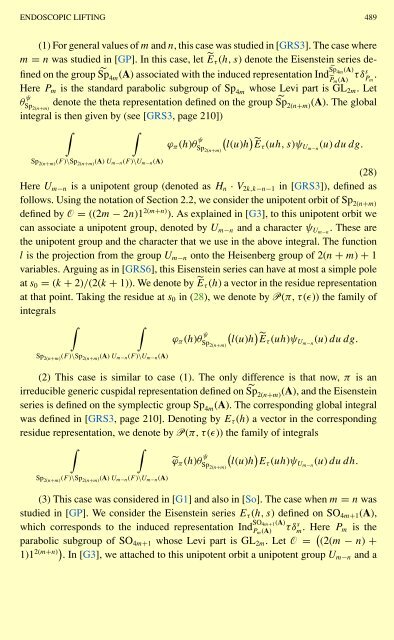A NULLSTELLENSATZ FOR AMOEBAS
A NULLSTELLENSATZ FOR AMOEBAS
A NULLSTELLENSATZ FOR AMOEBAS
Create successful ePaper yourself
Turn your PDF publications into a flip-book with our unique Google optimized e-Paper software.
ENDOSCOPIC LIFTING 489<br />
(1) For general values of m and n, this case was studied in [GRS3]. The case where<br />
m = n was studied in [GP]. In this case, let Ẽ τ (h, s) denote the Eisenstein series defined<br />
on the group ˜Sp 4m (A) associated with the induced representation Ind ˜Sp 4m (A)<br />
˜P m<br />
τδ s (A) P m<br />
.<br />
Here P m is the standard parabolic subgroup of Sp 4m whose Levi part is GL 2m .Let<br />
θ ψ Sp 2(n+m)<br />
denote the theta representation defined on the group ˜Sp 2(n+m) (A). The global<br />
integral is then given by (see [GRS3, page 210])<br />
∫<br />
∫<br />
ϕ π (h)θ ψ (<br />
Sp 2(n+m)<br />
l(u)h<br />
)Ẽτ (uh, s)ψ Um−n (u) dudg.<br />
Sp 2(n+m) (F )\Sp 2(n+m) (A) U m−n (F )\U m−n (A)<br />
(28)<br />
Here U m−n is a unipotent group (denoted as H n · V 2k,k−n−1 in [GRS3]), defined as<br />
follows. Using the notation of Section 2.2, we consider the unipotent orbit of Sp 2(n+m)<br />
defined by O = ((2m − 2n)1 2(m+n) ).Asexplainedin[G3], to this unipotent orbit we<br />
can associate a unipotent group, denoted by U m−n and a character ψ Um−n . These are<br />
the unipotent group and the character that we use in the above integral. The function<br />
l is the projection from the group U m−n onto the Heisenberg group of 2(n + m) + 1<br />
variables. Arguing as in [GRS6], this Eisenstein series can have at most a simple pole<br />
at s 0 = (k + 2)/(2(k + 1)). We denote by Ẽ τ (h) a vector in the residue representation<br />
at that point. Taking the residue at s 0 in (28), we denote by P(π, τ(ɛ)) the family of<br />
integrals<br />
∫<br />
Sp 2(n+m) (F )\Sp 2(n+m) (A) U m−n (F )\U m−n (A)<br />
∫<br />
ϕ π (h)θ ψ Sp 2(n+m)<br />
(<br />
l(u)h<br />
)Ẽτ (uh)ψ Um−n (u) dudg.<br />
(2) This case is similar to case (1). The only difference is that now, π is an<br />
irreducible generic cuspidal representation defined on ˜Sp 2(n+m) (A), and the Eisenstein<br />
series is defined on the symplectic group Sp 4m (A). The corresponding global integral<br />
wasdefinedin[GRS3, page 210]. Denoting by E τ (h) a vector in the corresponding<br />
residue representation, we denote by P(π, τ(ɛ)) the family of integrals<br />
∫<br />
∫<br />
˜ϕ π (h)θ ψ ( )<br />
Sp 2(n+m)<br />
l(u)h Eτ (uh)ψ Um−n (u) dudh.<br />
Sp 2(n+m) (F )\Sp 2(n+m) (A) U m−n (F )\U m−n (A)<br />
(3) This case was considered in [G1] and also in [So]. The case when m = n was<br />
studied in [GP]. We consider the Eisenstein series E τ (h, s) defined on SO 4m+1 (A),<br />
which corresponds to the induced representation Ind SO 4m+1(A)<br />
P m (A)<br />
τδm s . Here P m is the<br />
parabolic subgroup of SO 4m+1 whose Levi part is GL 2m .LetO = ( (2(m − n) +<br />
1)1 2(m+n)) .In[G3], we attached to this unipotent orbit a unipotent group U m−n and a
















